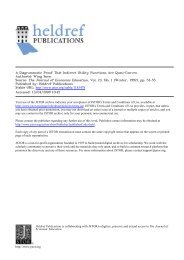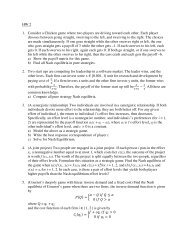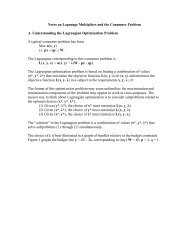The Meaning of Competition - Econ 402, Section 1 DECISION ...
The Meaning of Competition - Econ 402, Section 1 DECISION ...
The Meaning of Competition - Econ 402, Section 1 DECISION ...
Create successful ePaper yourself
Turn your PDF publications into a flip-book with our unique Google optimized e-Paper software.
Content Articles in <strong>Econ</strong>omics<br />
In this section, the Jo u rnal <strong>of</strong> <strong>Econ</strong>omic Educat i o n p u blishes art i cl e s<br />
c o n c e rned with substantive issues, n ew ideas, and re s e a rch findings in<br />
economics that may influence or can be incorp o rated into the teaching <strong>of</strong><br />
e c o n o m i c s .<br />
<strong>The</strong> <strong>Meaning</strong> <strong>of</strong> <strong>Competition</strong>:<br />
A Graphical Exposition<br />
Donghyun Park<br />
HIRSCHEL KASPER, <strong>Section</strong> Editor<br />
<strong>Competition</strong> is one <strong>of</strong> the most pivotal concepts in the undergraduate teaching<br />
<strong>of</strong> economics. Students usually learn <strong>of</strong> perfect competition as a particular market<br />
structure that is especially useful in gaining an understanding <strong>of</strong> resource<br />
allocation and efficiency. It is a market structure that consists <strong>of</strong> a large number<br />
<strong>of</strong> perfectly knowledgeable buyers and sellers who are individually too small to<br />
affect the market price and who engage in the exchange <strong>of</strong> a homogeneous good.<br />
Students also learn that competitors and resources can freely enter into and exit<br />
from competitive markets. Students are taught that perfect competition requires<br />
an absence <strong>of</strong> strategic interaction—firms do not take into account the possible<br />
responses <strong>of</strong> other firms to their own actions. A concept that is related to perfect<br />
competition yet distinct is that <strong>of</strong> price-takers—an industry consisting <strong>of</strong> firms<br />
that act as if they face essentially perfectly elastic demands for their products.<br />
Price-takers is a weak concept because it does not require that those firms be<br />
either knowledgeable or numerous.<br />
According to another definition <strong>of</strong> competition, competition and to compete<br />
refer to the same thing. To compete means to cut prices,advertise, invest in R&D,<br />
and so forth. <strong>Competition</strong> denotes a dynamic process <strong>of</strong> rivalry among firms in<br />
which only the fittest survive and thrive. This is probably what the concept means<br />
to most businessmen and entrepreneurs. Within economics, this interpretation <strong>of</strong><br />
competition is most closely identified with the neo-Austrian school <strong>of</strong> thought. I<br />
use the term neo-Austrian somewhat broadly to denote economists who view<br />
competition as a process rather than an equilibrium. I include Joseph Schum-<br />
D o n g hyun Pa rk is a lecturer at Nanyang Te ch n o l ogical Unive rsity in Singap o re (e-mail:<br />
adpark@ntu.edu.sg). <strong>The</strong> author wishes to thank three anonymous referees for helpful comments.<br />
Fall 1998 347
peter, although he is not, strictly speaking, a neo-Austrian. According to Ekelund<br />
and Saurman (1988, 75),<br />
<strong>The</strong> neo-Austrian view <strong>of</strong> competitive process dovetails perfectly with J. A. Schumpeter’s<br />
view <strong>of</strong> competition as “creative destruction.” In Schumpeterian terms, as in<br />
those <strong>of</strong> the neo-Austrians, competition is most fruitfully viewed in dynamic terms.<br />
Entrepreneurs are thus the prime movers <strong>of</strong> the economic process in the Austrian-<br />
Schumpeterian conception.<br />
An unfo rt u n ate neglect <strong>of</strong> dynamic competition exists in the undergra d u at e<br />
t e a ching <strong>of</strong> economics. Such neglect is unders t a n d able in light <strong>of</strong> time constra i n t s<br />
and teaching objective pri o rities. Howeve r, it is only fair that students be at least<br />
i n t roduced to the other competition, even at the level <strong>of</strong> principles. Otherwise, t h ey<br />
m ay develop a one-sided, p rejudiced view <strong>of</strong> a whole ra n ge <strong>of</strong> economic phenomena.<br />
<strong>The</strong> basic goal is to suggest a simple graphical method for developing a bri e f<br />
yet illuminating introduction to competition as a dynamic process and its re l at i o nship<br />
with the more familiar competition as a market stru c t u re.<br />
THE SCHUMPETERIAN VISION OF COMPETITION<br />
<strong>Competition</strong> as a dynamic process is hardly a new concept (Ekelund and<br />
Hébert 1981); its roots go as far back as Richard Cantillon. David Ricardo<br />
(1817), John Stuart Mill (1848), and Adam Smith (1776) all contributed to its<br />
evolution. <strong>The</strong>se and other classical economists thought <strong>of</strong> competition as a<br />
description <strong>of</strong> competitive behavior, especially with respect to prices. As McNulty<br />
(1968, 649) notes:<br />
Thus, the single activity which best characterized the meaning <strong>of</strong> competition in<br />
classical economics—price cutting by an individual firm to get rid <strong>of</strong> excess supplies<br />
—becomes the one activity impossible under perfect competition.<br />
Machovec (1995) and Kirzner (1997) provide recent surveys <strong>of</strong> the dynamic<br />
interpretation <strong>of</strong> competition. It would be accurate to say that this view <strong>of</strong> competition<br />
dominated classical economics, and the competition that appears in<br />
today’s textbooks came much later. In the process <strong>of</strong> evaluating the effects <strong>of</strong><br />
competition, Cournot (1838) pioneered the re-invention <strong>of</strong> competition as a market<br />
structure. Contributions by Jevons (1871), Edgeworth (1881), Clark (1900),<br />
and Knight (1921) have reinforced, refined, and perfected Cournot’s initial<br />
efforts. Stigler (1957) and McNulty (1968) provide excellent accounts <strong>of</strong> the historical<br />
evolution <strong>of</strong> the meaning <strong>of</strong> competition.<br />
As <strong>of</strong>ten happens, the original meaning <strong>of</strong> competition had largely been lost.<br />
Hayek, von Mises, Kirzner, Schumpeter, and other adherents <strong>of</strong> the neo-Austrian<br />
school <strong>of</strong> economic thought played leading roles in the rediscovery <strong>of</strong> competition<br />
as a dynamic process. Unlike their classical predecessors, the neo-Austrians<br />
emphasized elements <strong>of</strong> competitive behavior other than price cutting.<br />
<strong>The</strong>ir influential works helped later generations <strong>of</strong> economists understand the<br />
inherent conflict between the two definitions <strong>of</strong> competition. In particular, their<br />
contribution to the evolution <strong>of</strong> modern economics was to point out that competitive<br />
behavior had no role whatsoever in a world that satisfied all the assumptions<br />
<strong>of</strong> perfect competition. As Hayek (1948, 96) put it,<br />
348 JOURNAL OF ECONOMIC EDUCATION
<strong>The</strong> peculiar nat u re <strong>of</strong> the assumptions from wh i ch the theory <strong>of</strong> competitive equilibrium<br />
starts stands out ve ry cl e a rly if we ask wh i ch <strong>of</strong> the activities that are commonly<br />
d e s i g n ated by the verb “to compete” would still be possible if those conditions we re<br />
all sat i s fi e d. Pe r h aps it is wo rth recalling that , a c c o rding to Dr. Jo h n s o n , c o m p e t i t i o n<br />
is “the action <strong>of</strong> endeavo ring to gain wh at another endeavo rs to gain at the same time.”<br />
N ow, h ow many <strong>of</strong> the devices adopted in ord i n a ry life to that end would still be open<br />
to a seller in a market in wh i ch so-called “ p e r fect competition” p revails? I believe that<br />
the answer is ex a c t ly none. A dve rt i s i n g, u n d e rc u t t i n g, and improving (“diffe re n t i ating”)<br />
the goods or services produced are all ex cluded by definition — “ p e r fe c t ”c o mpetition<br />
means indeed the absence <strong>of</strong> all competitive activ i t i e s .<br />
As Hayek’s words make clear, the two meanings <strong>of</strong> competition contradict<br />
each other. By their very definitions, the paradigm <strong>of</strong> perfect competition precludes<br />
competitive behavior and competitive behavior precludes the paradigm <strong>of</strong><br />
perfect competition. How can sellers try to <strong>of</strong>fer buyers better deals when all sellers<br />
are assumed to be equal? How can sellers be equal when sellers are trying to<br />
<strong>of</strong>fer buyers better deals? Why do sellers need to advertise when buyers are<br />
assumed to have perfect information, and how can we assume that buyers have<br />
perfect information when we observe so much advertising around us?<br />
It seems that product homogeneity is the point <strong>of</strong> departure for the perfect<br />
competition model. <strong>The</strong> reason is that the perfect competition model describes a<br />
particular market structure, and the very notions <strong>of</strong> markets and market structures<br />
become less than clear-cut in the presence <strong>of</strong> product heterogeneity. On the other<br />
hand, once competition is viewed as a dynamic disequilibrium process rather<br />
than a specific kind <strong>of</strong> a static equilibrium, product homogeneity is not only<br />
unnecessary but unnatural as well. <strong>The</strong> whole point <strong>of</strong> competing, from a purely<br />
private point <strong>of</strong> view, is to be better than one’s rivals. And being better necessarily<br />
implies being different from and hence heterogeneity. Such selfish and selfinterested<br />
competition is also desirable from a social point <strong>of</strong> view because it<br />
promotes efficiency and social welfare.<br />
As any businessperson knows, there is more than one way <strong>of</strong> competing. One<br />
possibility is to compete on the basis <strong>of</strong> price. Yet it is quite clear that, for the<br />
most part, price competition was not what the neo-Austrians had in mind when<br />
they used the term. <strong>The</strong>ir competition was primarily quality competition, in<br />
which firms try to beat their competitors by producing and selling new, improved<br />
goods and services. In this connection, the works <strong>of</strong> Schumpeter are particularly<br />
illuminating. Schumpeter (1912, 1942) envisions a dynamic world in which new<br />
products and technologies constantly drive out old products and technologies.<br />
<strong>The</strong> first thing to go is the traditional conception <strong>of</strong> the modus operandi <strong>of</strong> competition.<br />
<strong>Econ</strong>omists are at long last emerging from the stage in which price competition<br />
was all they saw. As soon as quality competition and sales effort are admitted into<br />
the sacred precincts <strong>of</strong> theory, the price variable is ousted from its dominant position.<br />
However, it is still competition within a rigid pattern <strong>of</strong> invariant conditions,<br />
methods <strong>of</strong> production and forms <strong>of</strong> industrial organization in particular, that practically<br />
monopolizes attention. But in capitalist reality as distinguished from its textbook<br />
picture, it is not that kind <strong>of</strong> competition which counts but the competition<br />
from the new commodity, the new technology, the new source <strong>of</strong> supply, the new<br />
type <strong>of</strong> organization (the largest-scale unit <strong>of</strong> control for instance)—competition<br />
which commands a decisive cost or quality advantage and which strikes not at the<br />
Fall 1998 349
margins <strong>of</strong> the pr<strong>of</strong>its and the outputs <strong>of</strong> the existing firms but at their foundations<br />
and their very lives. This kind <strong>of</strong> competition is as much more effective than the<br />
other as a bombardment is in comparison with forcing a door, and so much more<br />
important that it becomes a matter <strong>of</strong> comparative indifference whether competition<br />
in the ordinary sense functions more or less promptly: the powerful lever that in the<br />
long run expands output and brings down prices is in any case made <strong>of</strong> other stuff.<br />
(1942, 84–85)<br />
It is possible to view Sch u m p e t e r ’s competition as a bro a d e r, d e eper defi n i t i o n<br />
<strong>of</strong> quality competition. Rega rdless <strong>of</strong> wh at one calls Sch u m p e t e r ’s vision <strong>of</strong> comp<br />
e t i t i o n , the kinds <strong>of</strong> competitive activities he deems most significant should be<br />
cl e a r. In the long ru n , wh at sep a rates the successful from the unsuccessful comp<br />
e t i t o rs is the ability to cre at e, i nve n t , and innovat e. For ex a m p l e, i nvention <strong>of</strong> the<br />
automobile eve n t u a l ly re n d e red effi c i e n cy in making stage coaches irre l eva n t .<br />
It is helpful to consider the strategic aspects <strong>of</strong> the innovative process as well<br />
as the determinants <strong>of</strong> success in innovative activities. Because R&D expenditures<br />
represent a choice variable that influences the probability <strong>of</strong> innovative success,<br />
it may be possible to argue in the extreme that firms may collude not to<br />
invest in R&D. Why would any firm invest in R&D when all the other firms can<br />
also do so and thus also enjoy innovative success?<br />
A possible answer is that although a relationship undoubtedly exists between<br />
R&D expenditures and innovation, the relationship is at best random. That is, a<br />
lot <strong>of</strong> uncertainty is involved in the innovative process. One can think <strong>of</strong> this<br />
process as a lottery where many players buy tickets, but only one winner<br />
emerges. A second possible answer is that some firms may be more efficient in<br />
R&D than others. Such efficiency may reflect the firms’ superior relative efficiency<br />
across all activities. One can say that the ultimate source <strong>of</strong> the innovator’s<br />
success is either luck or efficiency. In any case, in the real world, one<br />
observes a lot <strong>of</strong> innovations and a lot <strong>of</strong> commercial success resulting from<br />
innovations. Furthermore, the possibility that strategic collusion may reduce<br />
innovation does not in any way diminish the social benefits <strong>of</strong> dynamic competition<br />
but instead points out the social cost <strong>of</strong> collusion.<br />
TWO VIEWS OF COMPETITION AND TWO VIEWS OF MONOPOLY<br />
<strong>The</strong> two definitions <strong>of</strong> competition have drastically different implications<br />
about the welfare consequences <strong>of</strong> monopoly. It is worth noting that competition<br />
as a market structure and competition as a dynamic process are not only descriptive<br />
but normative as well. That is,they do not merely describe the nature <strong>of</strong> competition,<br />
they inform us that competition is socially beneficial. Because the two<br />
differ in how they perform the first task, it should come as no surprise that they<br />
differ in how they address the second task as well.<br />
Any microeconomics textbook explains why competitive markets are socially<br />
preferable to other kinds <strong>of</strong> markets in terms <strong>of</strong> efficiency; this is one <strong>of</strong> the primary<br />
lessons for undergraduate economics students. <strong>The</strong>y learn about the equality<br />
<strong>of</strong> price and marginal cost in competitive markets and the efficiency such<br />
equality implies. Neo-Austrians believe that their kind <strong>of</strong> competition is also<br />
350 JOURNAL OF ECONOMIC EDUCATION
socially desirable. For them, it is the Schumpeterian process <strong>of</strong> “creative destruction”<br />
in which products and technologies are always in a state <strong>of</strong> flux that is<br />
largely responsible for mankind’s material progress. In the stage coach analogy,<br />
the neo-Austrians would focus upon the social benefits associated with the invention<br />
<strong>of</strong> the automobile rather than those associated with a competitive market for<br />
stage coaches.<br />
<strong>The</strong> standard textbook theory <strong>of</strong> monopoly, l i ke the standard textbook theory <strong>of</strong><br />
c o m p e t i t i o n ,is essentially a theory about a particular market stru c t u re. More prec<br />
i s e ly, it describes a market in wh i ch only a single seller ch a rges a higher price and<br />
p roduces a lower quantity than would prevail in a competitive market. <strong>The</strong> deadweight<br />
losses or social costs associated with monopoly are <strong>of</strong>ten illustrated in the<br />
cl a s s room with the Harberger Triangle (Harberger 1954). As far as monopoly is<br />
c o n c e rn e d, wh at students basically learn is that monopoly is ineffi c i e n t ,i n e ffi c i e ncy<br />
is socially undesirabl e, and hence monopoly is socially undesirabl e. As any pri nciples<br />
textbook show s , the unmistakable teaching focus is on how a monopolist<br />
b e h aves rather than how a monopolist becomes a monopolist in the fi rst place. To<br />
the extent that the second issue is dealt with at all, it is usually only tange n t i a l ly in<br />
the context <strong>of</strong> nat u ral monopoly or collusion among sellers .<br />
Once we equate competition with to compete, as the neo-Austrians do, the distinction<br />
between competition and monopoly becomes blurred at best. What is the<br />
ultimate goal <strong>of</strong> competitive behavior if not to take business away from one’s<br />
competitors or, equivalently, to attempt to become ultimately a monopolist?<br />
Thus, equating competition and to compete necessarily amounts to equating com -<br />
petition and to monopolize.<br />
<strong>The</strong> Schumpeterian vision <strong>of</strong> omnipotent technological progress suggests that<br />
an important, if not the most important, means <strong>of</strong> beating one’s rivals is success<br />
in innovative activities. A host <strong>of</strong> legal as well as nonlegal barriers to entry protect<br />
successful innovators from competition for some time, and enables them to<br />
become monopolists. By their very definition, innovations <strong>of</strong> all descriptions create<br />
temporary monopolies. <strong>The</strong> essence <strong>of</strong> the competitive process is the continuous<br />
creation and destruction <strong>of</strong> such temporary monopolies.<br />
Most economists would agree that one needs to know the source <strong>of</strong> monopoly<br />
power before one can make judgments about a monopoly (Armentano 1990). It<br />
makes all the difference in the world whether a firm has achieved a position <strong>of</strong><br />
monopoly because it is run by a dictator’s nephew or because it produces cheaper,<br />
better products. Demsetz (1973) has played a prominent role in developing the<br />
notion <strong>of</strong> superior productive efficiency as a source <strong>of</strong> monopoly power. Imparting<br />
to the student a more balanced understanding <strong>of</strong> monopoly requires a discussion,<br />
however brief, <strong>of</strong> such views. Yet it seems to be true that, as with competition,<br />
undergraduate teaching <strong>of</strong> monopoly concerns itself almost exclusively<br />
with market structure.<br />
A SIMPLE STORY AND SOME SIMPLE DIAGRAMS<br />
I propose a simple method for teaching the undergraduate student about the<br />
differences between competition as a market structure and competition as a<br />
Fall 1998 351
dynamic process. This method is intended to provide an introduction to the differences<br />
between the two indirectly by graphically illustrating the social gains<br />
and losses from each definition <strong>of</strong> competition rather than by providing the definitions<br />
themselves. Thus, the student can gain a fuller understanding <strong>of</strong> the<br />
meaning <strong>of</strong> monopoly.<br />
<strong>The</strong> point <strong>of</strong> departure is the standard textbook analysis <strong>of</strong> competitive markets<br />
and monopolistic markets. For the sake <strong>of</strong> concreteness, consider the market<br />
for TV sets. Suppose there are two periods, period 1 and period 2. Initially, in<br />
period 1, there are only black and white TV sets. <strong>The</strong>n, a competitive market is<br />
more efficient than a monopolistic market. In Figure 1, triangle tkz indicates the<br />
social surplus associated with a competitive market,quadrangle tkrq indicates the<br />
social surplus associated with a monopolistic market, and triangle qrz indicates<br />
the efficiency losses associated with a monopolistic market.<br />
In period 2, assume an absence <strong>of</strong> Schumpeterian competition and innovation<br />
in period 1. In this case, if the factors affecting demand remain fairly stable as<br />
well, Figure 1 would be a reasonable representation <strong>of</strong> the period 2 market for<br />
black and white TV sets.<br />
Assume instead vigorous Schumpeterian competition in period 1. Suppose<br />
that a single firm emerges victorious in this competition by finding a way to significantly<br />
cut the costs <strong>of</strong> producing black and white TV sets and becomes a<br />
monopolist in period 2. In Schumpeterian terminology, cost-cutting ability may<br />
result from new technology, new source <strong>of</strong> supply, or new type <strong>of</strong> organization.<br />
<strong>The</strong>n it is perfectly possible for price, output, and social surplus under the<br />
monopolistic market in period 2 to be lower, higher, and higher, respectively,<br />
FIGURE 1<br />
Period 1 Market for Black and White TV Sets<br />
352 JOURNAL OF ECONOMIC EDUCATION
FIGURE 2<br />
Period 2 Market for Black and White TV Sets<br />
than the price, output, and social surplus under the competitive market in period<br />
1 (see Figure 2).<br />
In Figure 2, S represents the supply <strong>of</strong> the competitive industry while S′ represents<br />
the constant marginal costs <strong>of</strong> the period 2 monopolist, who charges a<br />
lower price and produces a higher output than would have prevailed in a competitive<br />
market without any Schumpeterian progress. <strong>The</strong> social surplus associated<br />
with the Schumpeterian monopolist in period 2 is quadrangle tkhy; the social<br />
surplus associated with the competitive industry in period 1 is tkz. <strong>The</strong>refore,<br />
quadrangle kzyh represents the dynamic efficiency gain or the increase in efficiency<br />
between the two periods.<br />
More precisely, quadrangle kzyh is an overestimate <strong>of</strong> this gain because<br />
Schumpeterian competition diverts resources from elsewhere in the economy.<br />
Because the monopolist is likely to advertise and advertising raises demand,<br />
quadrangle kzyh may also underestimate the dynamic efficiency gain although<br />
we have to take into consideration the fact that advertising also involves the use<br />
<strong>of</strong> scarce resources. <strong>The</strong> static efficiency loss caused by the market structure<br />
being monopolistic rather than competitive in period 2 is triangle yhx.<br />
Let us again assume Schumpeterian competition. Once again, a single winner<br />
emerges. This time, the winner wins not by finding a way to produce black and<br />
white TV sets but by inventing a new product—color TV sets—in period 1. <strong>The</strong><br />
inventor produces and sells the invention in period 2. Suppose that, in period 2,<br />
color TV sets completely displace black and white TV sets so the winner <strong>of</strong> the<br />
Schumpeterian technological race again becomes a monopolist.<br />
Fall 1998 353
FIGURE 3<br />
Market for Color TV Sets<br />
In Fi g u re 3, for the sake <strong>of</strong> graphical simplicity and cl a ri t y, I have assumed the<br />
m a rginal costs <strong>of</strong> the monopolist in period 2 to be identical to the supply <strong>of</strong> the<br />
c o m p e t i t ive industry in period 1. D′ rep resents the demand for color TV sets in<br />
p e riod 2 wh e reas D rep resents the demand for bl a ck and white TV sets in peri o d<br />
1. <strong>The</strong>n the social surplus associated with the Sch u m p e t e rian monopolist in period<br />
2 is quadrangle a k p f wh e reas the social surplus associated with the competitive<br />
i n d u s t ry in period 1 is again triangle t k z. Th e re fo re, pentangle at z p f rep resents the<br />
dynamic effi c i e n cy gain or the increase in effi c i e n cy from period 1 to period 2.<br />
More accurately, pentangle atzpf will overestimate this gain because the inventive<br />
process itself would have used up resources. On the other hand, pentangle<br />
atzpf may underestimate the gain because the monopolist is likely to advertise.<br />
<strong>The</strong> static efficiency loss in period 2 caused by the market structure being<br />
monopolistic rather than competitive is triangle fpr. Although Figure 3 should<br />
not have two different products on the same quantity axis, I have deliberately<br />
drawn it this way to illustrate the main point—successful innovations produce a<br />
greater social surplus even if they result in the displacement <strong>of</strong> competitive markets<br />
by monopolistic markets. It is perhaps best to think <strong>of</strong> Figure 3 as one diagram<br />
superimposed on top <strong>of</strong> another.<br />
SOME FURTHER STORIES<br />
It is possible to use this graphical method for a number <strong>of</strong> teaching purposes<br />
other than illustrating the difference between competition as a market structure<br />
and competition as a dynamic process. Most significant, it can illustrate the<br />
354 JOURNAL OF ECONOMIC EDUCATION
notion that not all monopolies are created equal. If a market that was competitive<br />
in period 1 turns monopolistic in period 2 for reasons that have nothing to do<br />
with superior productive efficiency (e.g., collusion among sellers or a dictator’s<br />
gift to his nephew), then what one would normally consider to be the static efficiency<br />
loss would be, in effect, the dynamic efficiency loss. To the extent that the<br />
monopolist is productively inefficient relative to a competitive market, as is plausible<br />
in the case <strong>of</strong> the dictator’s nephew, the dynamic losses would be even<br />
greater. However, a monopolist who has become a monopolist by winning the<br />
Schumpeterian competition will generate efficiency gains.<br />
It is helpful to remind the student that the possibility <strong>of</strong> socially beneficial<br />
monopolies or, more accurately, monopolistic markets carries significant implications<br />
for government policy. If one views competition primarily in the textbook<br />
sense, the government should be duly concerned about and attempt to influence<br />
market structure. If one views competition largely in Schumpeterian terms, the<br />
case for government interest in and interference with market structures is much<br />
weaker. More generally, a sound antitrust policy will have to take into account<br />
both static and dynamic considerations.<br />
Perhaps the classic example <strong>of</strong> the policymaker’s trade<strong>of</strong>f between the two<br />
kinds <strong>of</strong> considerations is that associated with patent policy. Patents confer a<br />
legal monopoly on the inventor <strong>of</strong> a new product or a new production technique.<br />
As such, they inevitably entail static efficiency losses. At the same time, they create<br />
dynamic welfare gains by creating the incentives to compete in the Schumpeterian<br />
sense.<br />
A sensible way to motivate a discussion <strong>of</strong> the trade<strong>of</strong>f implied by patents is<br />
to talk about how long a patent should last. <strong>The</strong> longer the life <strong>of</strong> the patent, the<br />
longer will the inventor enjoy a legal monopoly and hence the stronger will be<br />
his incentive to invent in the first place. But the longer the legal monopoly, the<br />
larger will be the magnitude <strong>of</strong> the deadweight losses. <strong>The</strong> shorter the life <strong>of</strong> the<br />
patent, the weaker will be the incentive to innovate, but the magnitude <strong>of</strong> the<br />
deadweight losses will be smaller.<br />
I apply the graphical method not so much to illustrate the socially optimal life<br />
<strong>of</strong> a patent as to illustrate the rationale for patents. If imitation is relatively easy,<br />
in the absence <strong>of</strong> a patent the market for the invented product would quickly<br />
become perfectly competitive, seemingly the best <strong>of</strong> both worlds. But what motivates<br />
would-be inventors and would-be innovators is self-interest and pr<strong>of</strong>its<br />
rather than something abstract called the social surplus. Furthermore, they incur<br />
very real costs during the course <strong>of</strong> their endeavors, costs that they would not<br />
incur in the absence <strong>of</strong> a lucrative reward. In the absence <strong>of</strong> patents, there would<br />
be no competitive market for the invented product for the simple reason that the<br />
product would not have been invented. Now one can talk about the social desirability<br />
<strong>of</strong> patents or legal monopolies using the graphical method presented here.<br />
CONCLUSION<br />
<strong>Competition</strong> is one <strong>of</strong> the most important concepts taught in undergraduate<br />
economics courses. Because <strong>of</strong> the way in which economic thought has evolved<br />
Fall 1998 355
over the years, competition has become one <strong>of</strong> the most ambiguous concepts in<br />
economics. Whereas classical economists thought <strong>of</strong> competition primarily as a<br />
behavioral term, the subsequent course <strong>of</strong> events has turned it into a description<br />
<strong>of</strong> a particular market structure. <strong>The</strong> neo-Austrian school <strong>of</strong> thought—in particular,<br />
Joseph Schumpeter—and those economists influenced by it have been<br />
redefining the concept along classical lines, although with a much greater<br />
emphasis on invention, innovation, and technological progress.<br />
In the classroom and in the textbooks, competition as a market structure continues<br />
to overwhelm competition as a dynamic process. This state <strong>of</strong> affairs is<br />
understandable in light <strong>of</strong> teaching objective priorities and time constraints. After<br />
all, the perfect competition paradigm represents a most indispensable tool for<br />
teaching about efficiency in allocation <strong>of</strong> resources. Yet the relative neglect <strong>of</strong> the<br />
dynamic interpretation is hardly a matter <strong>of</strong> passing interest. <strong>The</strong> reason is that<br />
students learn not only about competitive markets, they also learn that competitive<br />
markets are socially beneficial. Because competitive markets and competitive<br />
behavior, particularly <strong>of</strong> the Schumpeterian kind, <strong>of</strong>ten conflict with each<br />
other, there is a real danger that the narrow, one-sided understanding <strong>of</strong> competition<br />
imparted to the students will seriously prejudice and handicap their way <strong>of</strong><br />
looking at a wide range <strong>of</strong> economic phenomena.<br />
<strong>The</strong> method presented here represents an attempt to help redress this imbalance<br />
and thereby enri ch the students’ u n d e rstanding <strong>of</strong> the concept. It is<br />
inevitable that competition as a market structure will always loom larger than<br />
competition as a dynamic process within the realm <strong>of</strong> undergraduate teaching,<br />
given the central significance <strong>of</strong> allocative efficiency in that realm. Nevertheless,<br />
I strongly feel the need for at least a brief introduction to the “other” competition,<br />
an introduction for which I hope this suggested method will be adequate. It<br />
is worth using this method to expose the student to the trade<strong>of</strong>f between static<br />
and dynamic welfare considerations implicit in the competing definitions <strong>of</strong><br />
competition. Finally, my method is suitable even for principles students, and perhaps<br />
that is the level at which it should be used.<br />
REFERENCES<br />
Armentano, D. T. 1990. Antitrust and monopoly: Anatomy <strong>of</strong> a policy failure. 2nd ed. New York:<br />
Holmes & Meier.<br />
Clark, J. B. 1900. <strong>The</strong> distribution <strong>of</strong> wealth. New York: Macmillan.<br />
Cournot, A. A. [1838] 1929. Researches into the mathematical principles <strong>of</strong> the theory <strong>of</strong> wealth.<br />
New York: Macmillan.<br />
Demsetz, H. 1973. Industry structure, market rivalry, and public policy. Journal <strong>of</strong> Law and Eco -<br />
nomics 16 (April): 1–9.<br />
Edgeworth, F. Y. 1881. Mathematical psychics. London: C. Kegan Paul.<br />
Ekelund, R. B., and R. F. Hébert. 1981. <strong>The</strong> proto-history <strong>of</strong> franchise bidding. Southern <strong>Econ</strong>omic<br />
Journal 48 (October):464–74.<br />
Ekelund, R. B.,and D. S. Saurman. 1988. Advertising and the market process. San Francisco: Pacific<br />
Research Institute for Public Policy.<br />
Harberger, A. C. 1954. Monopoly and resource allocation. American <strong>Econ</strong>omic Review 44 (May):<br />
77–87.<br />
Hayek, F. A. 1948. Individualism and economic order. Chicago: University <strong>of</strong> Chicago Press.<br />
Jevons, W. S. [1871] 1911. <strong>The</strong> theory <strong>of</strong> political economy. London: Macmillan.<br />
Kirzner, I. M. 1997. Entrepreneurial discovery and the competitive market process: An Austrian<br />
approach. Journal <strong>of</strong> <strong>Econ</strong>omic Literature 35 (March):60–85.<br />
356 JOURNAL OF ECONOMIC EDUCATION
Knight, F. H. 1921. Risk, uncertainty and pr<strong>of</strong>it. Boston: Houghton Mifflin.<br />
Machovec, F. M. 1995. Perfect competition and the transformation <strong>of</strong> economics. London: Routledge.<br />
McNulty, P. J. 1968. <strong>Econ</strong>omic theory and the meaning <strong>of</strong> competition. Quarterly Journal <strong>of</strong> Eco -<br />
nomics 82 (November):639–56.<br />
Mill, J. S. 1848. Principles <strong>of</strong> political economy, I. London: John W. Parker.<br />
Ricardo, D. [1817] 1955. <strong>The</strong> principles <strong>of</strong> political economy and taxation. London: J. M. Dent.<br />
Schumpeter, J. A. [1912] 1934. <strong>The</strong> theory <strong>of</strong> economic development. Cambridge, Mass.: Harvard<br />
University Press.<br />
_______. 1942. Capitalism, socialism and democracy. New York: Harper and Brothers.<br />
Smith,A. [1776] 1937. <strong>The</strong> wealth <strong>of</strong> nations. New York: Modern Library.<br />
Stigler, G. J. 1957. Perfect competition, historically contemplated. Journal <strong>of</strong> Political <strong>Econ</strong>omy 65<br />
(February):1–17.<br />
Fall 1998 357


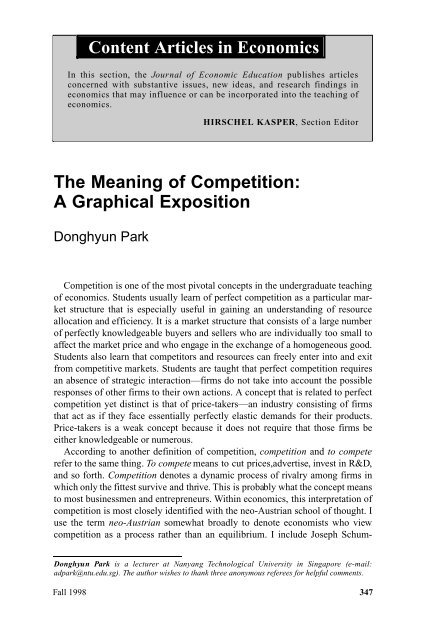

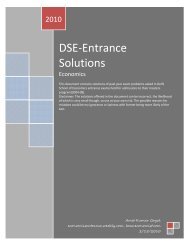
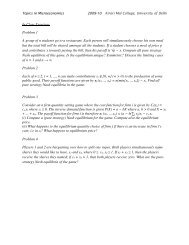


![2. Each of n ≥ 2, i = 1, ..., n can make contributions s i ∈ [0, w] (w ...](https://img.yumpu.com/19311695/1/190x245/2-each-of-n-2-i-1-n-can-make-contributions-s-i-0-w-w-.jpg?quality=85)
